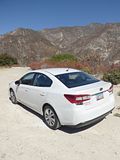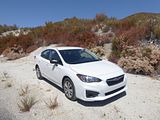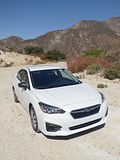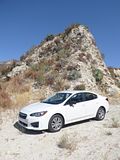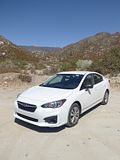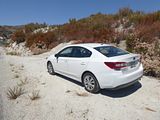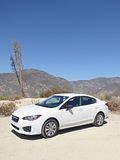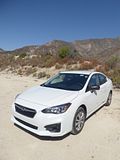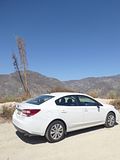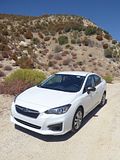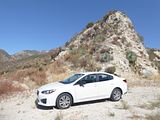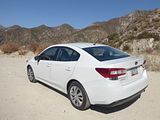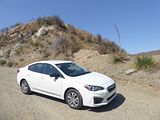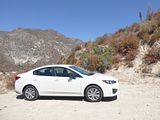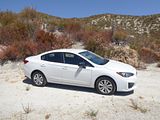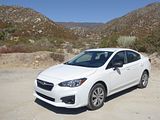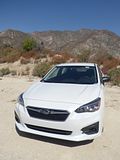Although anyone in Europe may find it hard to believe, Subaru continues to grow its sales on a global basis, with America being the top performing market. Spookily enough, just an hour before collecting this latest test car, I was reading a report on US sales in August 2019, which said that with sales up 9.3% and hitting an all time record over 70,000 units in the month, the brand has now achieved sales growth on a year-on-year basis over the last 93 months. The precise total of US Subaru sales was 70,039, which is not far short of double what the brand sells across the whole of Europe in a whole year, and most of those are purchased in Switzerland. So whilst few Europeans are buying the car that once had a strong following from its rally success of nearly 20 years ago, in America lots of people clearly are heading to the dealer and signing on the dotted line for one. Few of those buyers are the rental car companies. Subaru models remain an occasional sighting in any of the rental fleets, and when they are put out on the lot, the keys tend to be grabbed pretty quickly. So when I found this 2019 model year Impreza Sedan tucked behind a very large SUV and so hidden from view, I grabbed the keys before anyone else could. It seemed that I had, once again, found the rental car unicorn. In fact, this is the second example of the current, fifth generation, Impreza that I have driven, as on my trip in December 2018 I had found a hatch model, which I took for the day. That one turned out to be a 2017 model year car, with a big mileage on it. This one, with Arizona plates on it, was showing 13,300 miles, having been registered at the end of February 2019, and is a 2019 model year car, though the truth is that there have been no changes of note since this generation Impreza was introduced for the 2017 model year. It had the saloon body, and as I would later find out, was an entry spec car as opposed to having the Premium trim of that Hatch test car.
Subaru have retained their horizontally-opposed “boxer” flat four engine in the Impreza, meaning that the view under the bonnet is quite different from what you see in any of its rivals, with the unit mounted low, which of course is the whole point. The distinctive noise of a flat-four engine is still evident at times, most notably when you start it up from cold, though once underway it is largely quite well suppressed. In US market Impreza models, all cars have a 2.0 litre 4 cylinder unit which generates 152 bhp. That is around the same as you will find in any of its rivals, which means you would reasonably expect the Subaru to have performance that is much on a par with its competitors. I’m not convinced that it quite achieves that and indeed quoted acceleration times suggest it is one of the slowest cars in its class. Whilst the engine is quite smooth at lower revs, as you work it harder it becomes a lot noisier. And you probably will need to work it quite hard to get the acceleration you need out of it. I think the real reason for that is the CVT gearbox, which did seem somewhat ill-matched to the car. The supposed advantage of always being in the right gear just did not apply, and the transmission seemed slow catching up with what the throttle pedal was doing and there was always something of a droning sound that emerged. I suspect a manual gearbox Impreza is a rather nicer car to drive, even if it is not that fast. Fuel economy was comparable to what I have seen in the Subaru’s rivals, too. I needed to put in 4.77 gallons to fill it, having covered 150 miles, which computes to 31.44 mpg US or 37.56 mpg Imperial which is slightly less than I achieved with the hatch model, but admittedly I drove that one more than twice as far and did quite a proportion of that test mileage at a steady speed whereas this test had more stop/start and mountain work in the mileage.
Subaru’s all-wheel drive system is standard and this is perhaps the car’s most distinguishing feature, though in places like Southern California, it does not deliver the benefits that Subaru fans really appreciate when the weather gets bad and the grip reduces. The steering is well weighted, with a decent amount of feel. The idea of the flat four engine is that it gives the car a lower centre of gravity and this should help with the handling. Frankly, it does not really have enough power for this to make much difference, but the Impreza does have plenty of grip and it corners well with very little in the way of body roll. Entry level trimmed cars like this one come on steel wheels that are 205/55 R16 in size, and the result is that the ride is decent, striking the right balance between comfort and not being too soggy. There were no concerns about the effectiveness of the brakes, though thankfully I never needed to put them to the ultimate test. There is a conventional pull-up handbrake fitted between the seats. Visibility is generally good with a large glass area by modern standards, a big windscreen and useful front quarterlights whilst the door mirrors provide a clear view of what is behind and alongside. The tail is quite stubby and anyway there is a rear-view camera, to show you what is behind and how close it is.
Subaru have never been famous for high quality interiors and whilst their recent efforts have been much better than they were a few years ago, class standards have also improved, so this one came across as no better than acceptable. The dash and associated trim is mostly black with some slightly odd carbon-fibre-like weave plastics on both the dash and door casings. There was a plastic-moulded steering wheel in the test car as this was in entry level spec. And looking around the interior, which looked a bit sparse, you will realise what you have to forgo to keep the price down. That said, what is there is all perfectly usable and everything you actually need is present. There is a simple instrument cluster with two large dials for the speedometer and rev counter, with the fuel gauge inset between the two. There is also an economy meter inset in the lower portion of the speedometer, which shows a simple + and – to reflect how the consumption is varying. The sort of digital display trip computer data you often get in the instrument cluster is presented in an area high on the centre of the dash. The graphics have something of an old-school look to them. There are two column stalks which include the lights and there are audio repeater functions and cruise control buttons on the spokes of the steering wheel. The centre of the dash has vertically mounted air vents on either side of the 6.5″ colour touch sensitive display screen. This houses Subaru Link but in the case of an entry level trim car that means AM/FM radio and not much else. There are a number of physical buttons beneath the screen, so it is easy to use. There are just 4 speakers but even so sound quality was perfectly acceptable. Below the unit there are three rotary dials for the air conditioning.
Seat upholstery is cloth, in two different shades of very dark grey and as you might expect, adjustment is all manual. There is only a height adjuster for the driver. The steering column does telescope in and out as well as up and down. It was not that hard to get the driving position I wanted, but sadly, I found that the seat cushion was not that comfortable, so whilst there was plenty of space, with headroom feeling generous even though this Impreza is not quite as tall as its predecessor, I still would not be particularly keen on spending long periods of time behind the wheel
Space in the back of the Impreza is pretty decent for what by American standards is quite a small car. Even with the front seats set well back, there is ample legroom. Part of the reason for this is because passengers here sit relatively upright. Even so, headroom is sufficient. I think it would be a rather tight squeeze to get three adults in here, not least as the centre console unit comes back quite a long way. There is no central armrest and further evidence of the base model spec comes from the fact that whilst there are pockets on both doors, there is only one map pocket on the back of the front seats.
There is no external release for the boot, so you have to use either the lever inside the car or press the buttons on the key fob. Once open, you will find that the boot is a decent size, though it is noticeably narrower between the wheel arches than it is at the back of the car. The boot floor is quite a bit lower than the base of the boot lid, so if you regularly carry large and heavy items, you might find the hatch model is a better bet. There is a bit more space under the floor around the space-saver wheel. There are split folding backrests, so you can create a much longer load platform should this be called for. Inside the cabin, there is a good-sized glovebox, a recessed cubby in front of the gearlever, pockets on the doors and there is a small cubby under the armrest, though for those who sit well forwards, it is well back and a bit awkward to access.
Subaru offer the Impreza with a choice of four door saloon or five door hatchback bodies. The trim versions and equipment level are more or less the same across the pair. For the US market, every Impreza is powered by a 2.0-litre four-cylinder engine that makes 152 bhp and 145 lb/ft of torque. More power is available from the related, high-performance WRX and WRX STI models. A five-speed manual transmission is standard on the 2.0i and Sport models, and a continuously variable automatic is optional on those and standard on Premium and Limited trims. There are four trim levels: base, Premium, Sport and Limited. The test car was a base spec car, and for most this may seem a little too basic, lacking a few of the features that buyers rather expect these days. The base 2.0i comes standard with 16-inch steel wheels, daytime running lights, remote locking and unlocking, cloth upholstery, carpeted floor mats, a rearview camera, a tilt-and-telescoping steering wheel, a driver information display, a height-adjustable driver’s seat, cruise control, a 60/40-split folding rear seat, Bluetooth, a 6.5-inch touchscreen, and a four-speaker audio system with a USB port and Android Auto and Apple CarPlay compatibility. The available EyeSight suite of driver aids adds adaptive cruise control, forward collision warning with automatic braking, automatic reverse braking, and lane departure warning and mitigation. This option also adds an upgraded driver information display. The Premium trim is better equipped, with alloy wheels, automatic headlights and wipers, heated mirrors, a windshield wiper de-icer, a sound-reducing windshield, heated front seats, Subaru Starlink services, and a six-speaker audio system with a CD player, satellite radio and a second USB port. Models equipped with the CVT also get steering-wheel-mounted paddles with seven simulated gears, while hatchback models add roof rails and a cargo cover. An available package combines blind-spot monitoring with rear cross-traffic alert, cornering lights and the EyeSight suite. This package can be ordered with or without a power sunroof. For drivers who want a more exciting version of the Impreza, there’s the Sport. It comes with 18-inch alloy wheels, a rear spoiler, a sport-tuned suspension, keyless entry and ignition, an 8-inch touchscreen, a leather-wrapped steering wheel, unique interior and exterior trim, and active torque vectoring for improved traction. EyeSight, the sunroof and blind-spot monitoring are bundled into a package that also includes an eight-speaker Harman Kardon premium audio system. At the top of the Impreza range, there’s the Limited model. It builds off the Premium trim, adding 17-inch alloy wheels, adaptive LED headlights with automatic high beams, foglights, keyless entry and ignition, the 8-inch touchscreen, leather upholstery, a leather-wrapped steering wheel, a six-way power driver’s seat, a rear armrest, automatic climate control, the EyeSight system and reverse automatic braking. Blind-spot monitoring and the sunroof are bundled into a package. It can be ordered with or without the Harman Kardon system and navigation.
I handed the Impreza back having reached exactly the same conclusion as I did when sampling the hatch model. That’s hardly surprising, as barring the different rear end, these are essentially the same cars. The Impreza is a perfectly acceptable family-sized car that will get the job done. Its weakest points are the engine and the CVT transmission. And if the 2 litre unit of the test car is a bit weedy, then heaven help the 1.5 litre units to be found in European market cars. What is lacks, though, is any compelling reason to prefer one over a long list of rivals, unless you live somewhere where the standard All Wheel Drive system is a real bonus. That largely explains why it is only in Switzerland where Europeans buy the marque in any quantity and why sales are so strong and still growing in parts of America. That’s not the Pacific South West, so you don’t see that many on the road and you certainly don’t see them in the rental car fleets, but in the Snow Belt States, it is a different matter. It could be worth a punt if you do see one lined up with all the other mid-sized cars, though I think I would want one in Premium trim, as the entry level spec really did feel like you were missing out just that bit too much for 2019, but on the whole I would have to say that if there were a choice of lots of alternative models for the same money, this is not the one I would pick. Just as European buyers are not doing.








